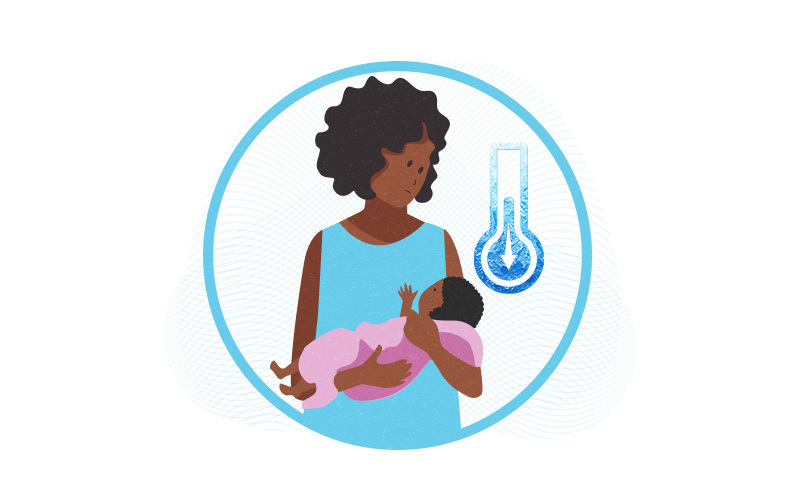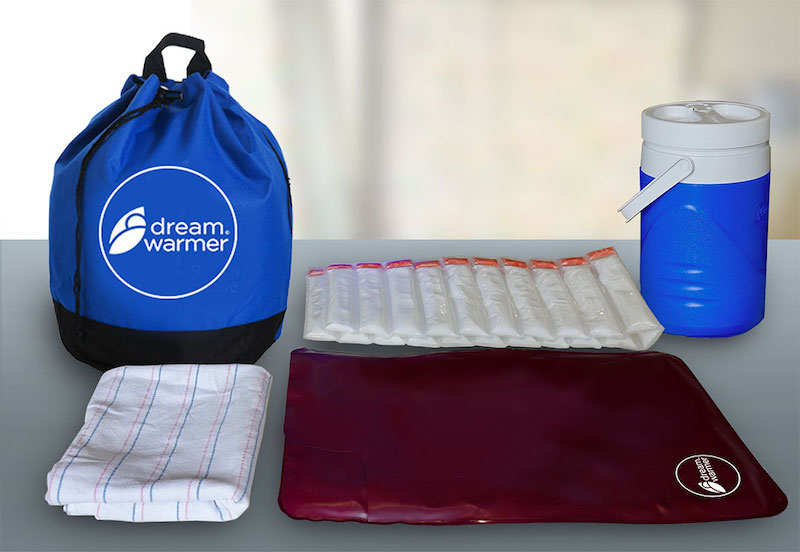A successful, low-cost reusable treatment for infant hypothermia

Key Takeaways
- Infant hypothermia leads to about one million deaths each year, primarily in low- and middle-income countries.
- A study in rural Rwanda of a non-electric infant warmer developed by Boston Children’s showed it successfully raised infants’ core temperatures and improved survival in preterm infants with hypothermia
Infant hypothermia contributes to approximately one million deaths each year, primarily in low- and middle-income countries. To address this common source of illness and death, researchers from Boston Children’s Hospital and colleagues in Rwanda developed a low-cost, reusable, non-electric infant warmer. In the largest study of the warmer to date, they found that it successfully increased infants’ core temperature and was associated with lower rates of infant mortality.
Mattress warms to normal body temperature
The warmer is a mattress that contains 12 wax “candles” made of a material specially designed to melt at exactly skin temperature. The mattress is first put in a container of 1.7 liters of boiled water to warm up to normal body temperature and then placed into an insulating sleeve so that it retains heat for six hours of use. Once the candles cool, the mattress can be cleaned and reused multiple times.

Study finds warmer was effective and safe
Anne Hansen, MD, MPH, of the Division of Newborn Medicine has been working in Rwanda for more than a decade to address preventable causes of infant disease and death. “Infant hypothermia is a silent killer,” says Hansen, lead author of the study and medical director of Boston Children’s neonatal intensive care unit. “But it’s modifiable risk factor that can have a huge impact on survival and on the long-term neurodevelopment of these babies.”
Earlier research found that the warmer was effective, safe, and usable without much training. For the current study, she and her colleagues evaluated the warmer’s ability to increase body temperature rates in infants who were hypothermic or weighed less than 2.5 kg (5.5 pounds), compared to the standard of care in rural Rwandan hospitals.

“The final design is a skin temperature heating pad that the infant can either lie on or that can be used around an infant’s back in addition to skin-to-skin contact with the mother,” says Hansen, who worked with engineers from the Lawrence Berkeley Lab at the University of California, Berkeley, to develop it. Compared with a $5,000 incubator, the warmer costs about $100.
Over the study period, from November 2019 to July 2020, 464 pre-term infants at 10 of the busiest neonatal wards in rural Rwanda used the warmer 892 times, mostly due to hypothermia. The warmer raised the core temperature of 67 percent of treated pre-term infants. Infant deaths also were lower: 0.9 percent compared with 2.8 percent of infants who were not treated with the warmer.
Other findings from the study:
- Use of the warmer did not lead to excessive core temperatures in the infants (i.e, above 37.5° C).
- No burns, other safety concerns, or instances of incorrect warmer use were observed.
Results of the study were published in eClinicalMedicine from The Lancet.
“This is a good option for treatment in settings lacking access to incubators, whether it is because they are too expensive, there is not a reliable source of electricity, or the hospital staff does not have the extensive training required for correct use and maintenance,” says Hansen.
It also provides an alternative for mothers who cannot provide adequate skin-to-skin care to keep babies sufficiently warm, she adds
“Because treating neonatal hypothermia is relatively easy given the appropriate equipment, we hope this warmer can play a significant role optimizing the health of vulnerable infants in low- and middle income countries,” says Hansen. She is now partnering with others with the goal of distributing the infant warmer across Sub-Saharan Africa as well as Haiti and Chiapas, Mexico.
Learn more about the Division of Newborn Medicine.
Related Posts :
-

“Observe. Be open.”: How Boston Children’s nurses are changing the future of global health
Ashley Birch, MSN, CPNP, a Boston Children’s pediatric nurse practitioner and Global Nursing fellow, didn’t expect a trash ...
-

Unveiling the hidden impact of moyamoya disease: Brain injury without symptoms
Moyamoya disease — a rare, progressive condition that narrows the brain’s blood vessels — leads to an increased risk of stroke ...
-

Forecasting the future for childhood cancer survivors
Children are much more likely to survive cancer today than 50 years ago. Unfortunately, as adults, many of them develop cardiovascular ...
-

Genomic sequencing transforms a life: Asa’s story
Asa Cibelli feels like he’s been reborn. The straight-A middle schooler plays basketball and football, does jiu jitsu, is ...





